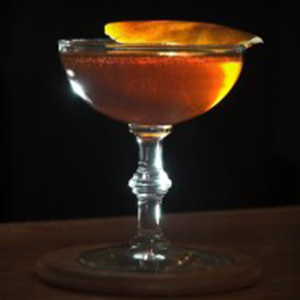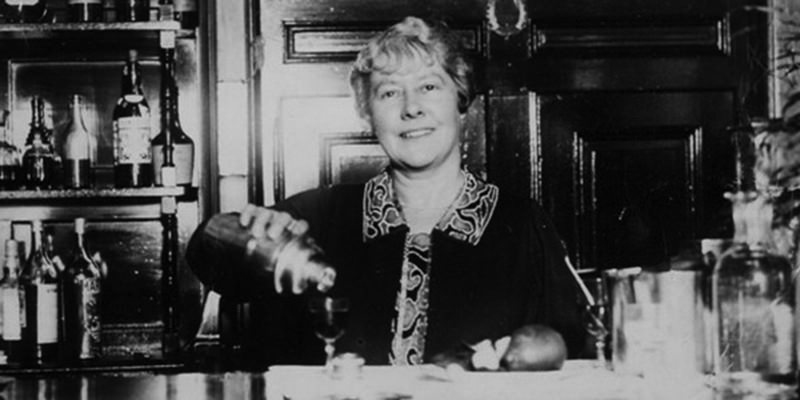It’s Women’s History Month, meaning web outlets everywhere are trotting out token female figureheads to celebrate, briefly, and put back into the “Important Ladies” closet for the rest of the year. Right? Probably, and gross, but not us. Sure, we’re choosing this month to tell you about Ada Coleman, one of the first, funniest, and most iconic female bartenders of all time. But this isn’t like studying for a U.S. history test and then emptying your brain of all knowledge of the Teapot Dome Scandal. After you read this—and not because of us, but because of “Coley”—we’re pretty sure you’ll remember her, like all of her customers did, long after they met her.
In a way, the female tokenism of Women’s History Month would have made some sad sense to Coleman. She lived in an era where male bartenders numbered 55,000 while females topped out at a whopping 147 (to be fair, that figure was from the States, while Coleman worked out of London; but things there weren’t wildly progressive there, either). Her fame behind the bar came about with more serendipity than use of any convenient professional inroads for the ladies. And while Coleman was eventually, and ardently, adored by her glitz and glamour clientele, there were some less than subtle objectors to her position. But we’ll get to that in a few.
First, Coleman’s rise to fame. She began her career in 1899, having gotten a job at Claridge’s Hotel from her father’s former employer. Coleman was just 24 at the time, serving simple drinks to hotel guests. As cocktail fate would have it, Coleman was one day asked to make her first honest-to-goodness cocktail. As she would tell The Daily Express 26 years later, “I remember it was a Manhattan that I made first, and that it was Fisher, the wine butler, who gave me my first lesson.”
Fisher might have been a good, and generous, teacher. But Coleman was an apt pupil, and her skills eventually got her a job at the new American Bar of the famous Savoy Hotel in London. The American Bar had been open for about as long as Coleman had been working, and by 1903, she had worked her way up to be the bar’s first—and only, as in to this day—female head bartender.
And this is where the fun really starts. Because beyond being an early experimenter behind the bar, Coleman was a hoot. She’d always been interested in the arts and theater, and at the posh American Bar, she ended up catering to a lot of the era’s richest and glitziest. Big, fat famous names like Marlene Dietrich, Charlie Chaplin, the Prince of Wales, even Mark Twain. Basically the equivalent of serving Tilda Swinton (thinking of strong female androgyny), Jack Black (great physical comedian with a mild sad depth?), the, well, the Princes of Wales, and Tina Fey (‘cause she won the Mark Twain award for American Humor and is a pithy observer of American culture, and meatball subs).
Coleman didn’t just have fun behind the bar. She’d bring the party, and the clientele, home, hosting parties and generally living the life of consummate hostess. Her nickname, “Coley,” is the least evidence we have of how much her customers loved her.
And then there’s the “Hanky Panky,” the cocktail that keeps Coleman’s name in circulation like a life preserver (when really, her name should be in circulation all the time). The drink has an equally charming history, right in line with Coley’s reputation. In the same interview with the Daily Express, Coleman recounts how the drink came to be. Charles Hawtrey was a comedic actor, “one of the best judges of cocktails that I knew,” Coleman recalled. “Some years ago, when he was overworking, he used to come into the bar and say ‘Coley, I am tired. Give me something with a bit of punch in it.’”

Coleman had already been interested in experimenting—and would often poke over recipes for the sake of pleasing clientele, especially Hawtrey. “It was for him that I spent hours experimenting until I had invented a new cocktail,” she said. “The next time he came in, I told him I had a new drink for him. He sipped it, and, draining the glass, he said ‘By Jove!’”—people said that back in the day—“’This is the real hanky-panky!’ And Hanky-Panky it has been called ever since.”
We should note, “hanky-panky” didn’t have the same connotation in Britain. It meant something closer to magic or witchcraft, hence Hawtrey’s exclamation. He wasn’t yelling, “This is sex in a glass!” Though we’d take that compliment anytime, and have often shouted it ourselves. However, the double meaning of witchcraft and, well, intimacy have stuck to the drink ever since.
Coleman, meanwhile, mixed on behind the American Bar until 1926, overlapping with the already famous Harry Craddock (author of The Savoy Cocktail Book, where just one Coleman drink, the Hanky Panky, appears), for a year or two. It’s suggested Coleman was possibly forced out of the American Bar because Craddock wasn’t super happy with a female head bartender. (The fact that another female employee was fired at the same time, and that Coleman simply moved stations, from bar to hotel floral shop, seems to suggest it wasn’t a simple retirement.)
However it went down, Coleman attended to it gracefully, after a nearly 30 year career and with a lot of love from some of the most famous and culturally significant folks of her (or any) time. And her time lasted a while. Coleman passed away in 1996, at 91 years old, just at the cusp of the resurgence of mixology, both Stateside and in the U.K. Not sure what she’d make of the modern mixology scene—though fairly certain she’d have loved to join LUPEC, been generally excited to have far more female compatriots behind the bar, and definitely (definitely) thrown a few great parties.

